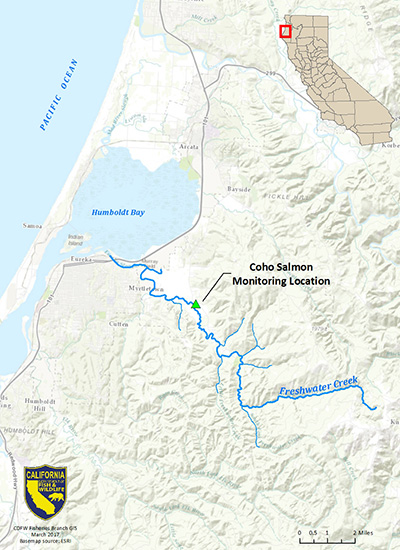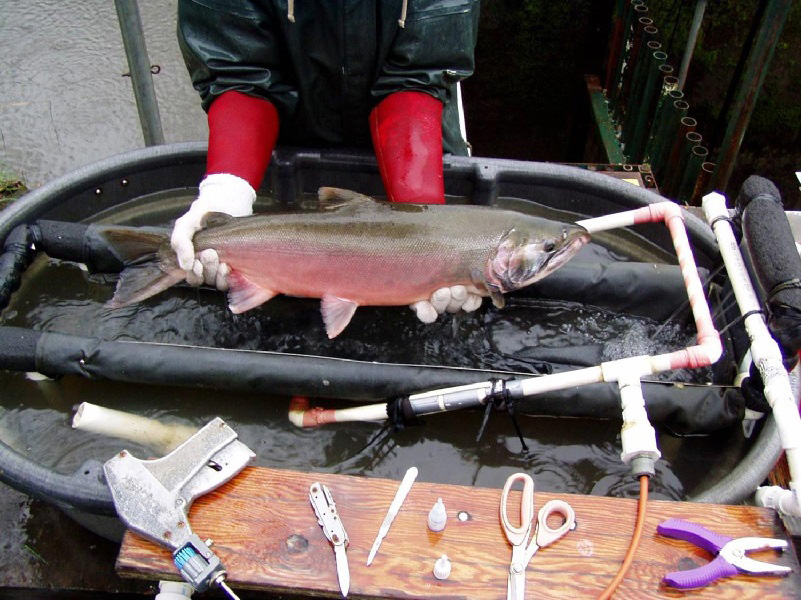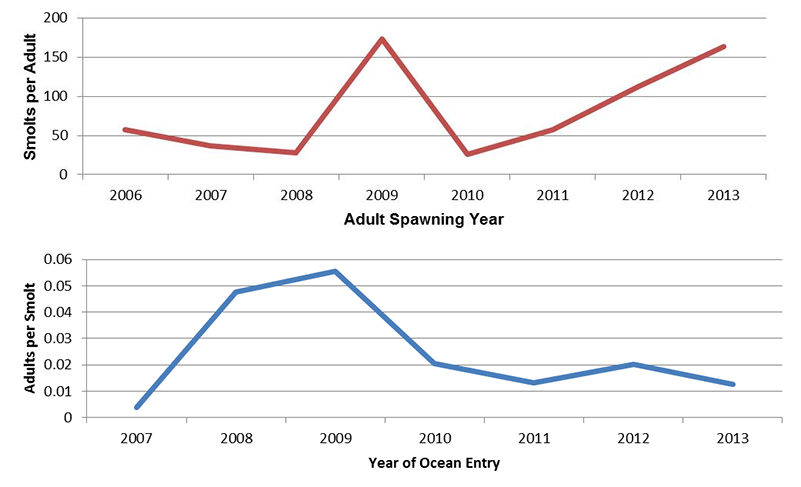Freshwater Creek, Humboldt County
Species / Location
 Figure 1. Coho Salmon spawning on Freshwater Creek, Humboldt County, CA. CDFW photo S. Ricker.
Figure 1. Coho Salmon spawning on Freshwater Creek, Humboldt County, CA. CDFW photo S. Ricker.
 Figure 2. Map of Freshwater Creek Coho Salmon monitoring location in central Humboldt County. (click/tap to enlarge)
Figure 2. Map of Freshwater Creek Coho Salmon monitoring location in central Humboldt County. (click/tap to enlarge)
 Figure 3. Male Coho Salmon being checked for a Passive Integrated Transponder tag at a capture facility on Freshwater Creek, Humboldt County CA. CDFW photo C. Anderson.
Figure 3. Male Coho Salmon being checked for a Passive Integrated Transponder tag at a capture facility on Freshwater Creek, Humboldt County CA. CDFW photo C. Anderson.
The current drought has impacted populations of federally listed Southern Oregon-Northern California Coho Salmon and Northern California steelhead in Freshwater Creek, a coastal Humboldt County stream (Figure 1).
Need for Drought Stressor Monitoring
Salmon are born in streams and rivers, but travel to the ocean to mature before returning to spawn in the same streams in which they were born. Because of this complex life history, monitoring the dynamics of a population at multiple life history stages allows California Department of Fish and Wildlife (CDFW) biologists to untangle the different effects that climatic conditions have on the population.
Drought has persisted in California since 2012, making threatened and endangered populations of Coho Salmon and steelhead increasingly vulnerable throughout their life history. Reduced rainfall and stream flow can relegate spawning adults to sub-optimal habitats. Low summer flows can decrease the availability of food and habitat for salmon in the smolt life stage, which migrate from freshwater to the ocean.
CDFW staff collected data on Coho Salmon abundance over multiple years in Freshwater Creek, a stream located in Humboldt County (Figure 2). This long term monitoring effort allows CDFW biologists to evaluate the drought’s relative effects on salmon in marine and freshwater habitats throughout their life history.
Stressor Monitoring Efforts
CDFW used Passive Integrator Transponder tags implanted into fish to monitor Coho Salmon populations. Tagged individuals are tracked throughout their migration using in-river tag detection stations. Using these tools, CDFW scientists build long term datasets that provide valuable information about the drought’s effect on Coho Salmon reproduction, dispersal, and survival in both freshwater and saltwater habitats (Figure 3).
Findings
Despite the severe impacts of the drought, the number of smolts produced per Coho Salmon increased each year from 2010 to 2013. (Figure 4 Top Panel). However, ocean survival of Coho Salmon has declined over a similar time span (Figure 4 Bottom Panel). This trend is likely due in part to changes in the California and Alaska currents, which have led to shifts in the timing and amount of food available to young salmon after they migrate to sea.
Future Efforts
 Figure 4. Relative productivity of stream dwelling (Top panel) and ocean maturing (Lower panel) phases of Coho Salmon population in Freshwater Creek, Humboldt County. The observed decline in ocean maturing Coho Salmon may be the result of changing ocean conditions, including food availability.
Figure 4. Relative productivity of stream dwelling (Top panel) and ocean maturing (Lower panel) phases of Coho Salmon population in Freshwater Creek, Humboldt County. The observed decline in ocean maturing Coho Salmon may be the result of changing ocean conditions, including food availability.
Given the instability of the global climate and the effect it has on California species, CDFW is dedicated to both understanding the demographics of fish and wildlife populations and their reaction to a changing environment. Monitoring information allows CDFW to mitigate these changes through informed management practices and habitat restoration. Information regarding where, when, and under what conditions animals are distributed and how they survive in various habitats is often the base information necessary for directed resource management during the changing conditions of at risk species. CDFW will continue to monitor the impacts of drought on Coho Salmon throughout their lifecycle, and use this information to make management decisions, such as if and when a fish rescue should be performed. Efforts like this project and others across California play a vital role in ensuring valuable fisheries resources remain intact for future generations to enjoy.